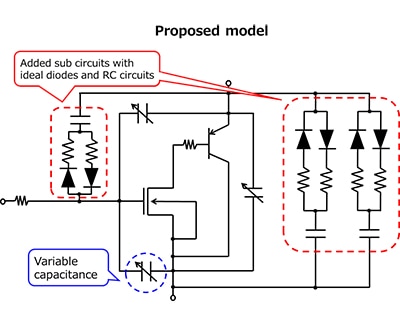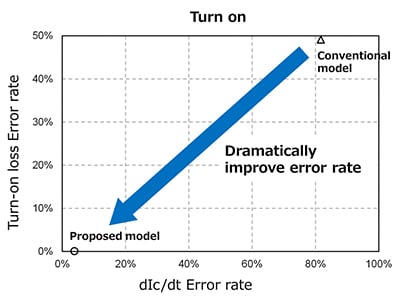Toshiba’s IGBT/IEGT Compact Modeling Realizes Highly Accurate Prediction of Power Efficiency and EMI Noise
June 14, 2019
Toshiba Electronic Devices & Storage Corporation
TOKYO -- Toshiba Electronic Devices & Storage Corporation (“Toshiba”) has developed a compact model for highly accurate simulation and prediction of power loss and noise from electromagnetic interference (EMI) in Insulated Gate Bipolar Transistors (IGBT) and Injection Enhanced Gate Transistors (IEGT). The proposed model reproduces measured turn-on and turn-off switching waveform more accurately that current approached, and reduce the error rate by over 95% while cutting simulation time to less than one-thirtieth. [1]
Details were reported at the IEEE-sponsored International Symposium on Power Semiconductor Devices and ICs 2019 (ISPSD 2019) in Shanghai.
Power devices are essential components of inverter and converter circuits. IGBT and IEGT, which integrate MOS-gate control with bipolar conductivity modulation, are particularly important in high power applications, where they realize high input impedance and low on-resistance. Growth of the electric vehicle and renewable energy markets continues to drive forward demand for IGBT and IEGT.
In developing IGBT and IEGT, electron flow and hole flow are important considerations that produce complex switching performance. Accurate circuit simulation is essential to predict the power efficiency and EMI noise, as unpredicted EMI noise can damage the equipment, but conventional models do not sufficiently reproduce switching behavior. Increasing resistance in the circuit can damp EMI noise, but reduce the efficiency of the equipment.
Drawing on its extensive know-how in circuit modeling technology and world-class expertise in power devices, Toshiba has developed a new compact simulation model for IGBT and IEGT that realizes the accurate prediction of power-loss and EMI noise. It has two specific features.
Two additional parallel sub circuits with an ideal diode and resistor and capacitor (RC) circuit reproduce switching. Conventional models can represent either hole or electron flow, but the sub circuits can represent both schematically, securing accurate prediction of the complex switching performance of bipolar transistors.
The proposed model also introduces a capacitor that shows change in capacitance over time. The conventional model uses a capacitor with stable capacitance regardless of voltage to transistors, but the capacitor in the proposed model is formed by a non-linear function that respond voltage change. This realizes an accurate prediction of EMI noise when switching.
Optimization of the circuit structure achieves a shorter simulation time for inductive load switching than the conventional model.
Toshiba will continue to improve accuracy of the proposed model and aim for its early utilization.
Notes
[1] Conventional and general models consists of current source and RC circuits. As of May 2019, Toshiba Electronic Devices & Storage Corporation.
Comparison of conventional and proposed model


Improved error detection rate


*Company names, product names, and service names may be trademarks of their respective companies.
Information in this document, including product prices and specifications, content of services and contact information, is current on the date of the announcement but is subject to change without prior notice.